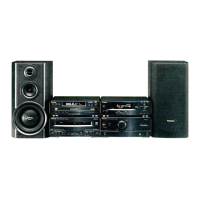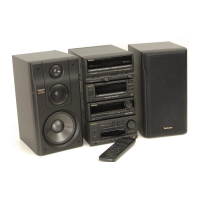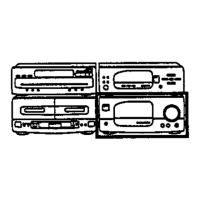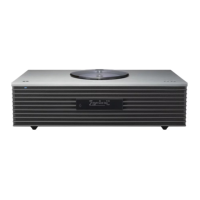Do you have a question about the Technics SC-CH900 and is the answer not in the manual?
| Brand | Technics |
|---|---|
| Model | SC-CH900 |
| Category | Stereo System |
| Language | English |
Safe use of AC outlets to prevent fire hazards.
Proper method for unplugging to avoid electric shock.
Ensuring proper airflow and avoiding harmful locations for unit longevity.
Warnings against self-repair and handling water spills safely.
Protecting children and avoiding damaging cleaning agents.
Specific wiring color code for UK power cords.
Avoiding magnetism, extreme temperatures, dust, and vibration.
Proper handling during transport and ensuring ventilation clearance.
List of all accessories provided with the system.
Guide to inserting batteries and general battery usage advice.
Tips for effective remote control operation and signal reception.
Visual guide for stacking system components vertically.
Visual guide for arranging system components horizontally.
Diagram showing component placement with speakers and TV.
Instructions for connecting the flat control cable between components.
Correctly connecting speaker cables to the amplifier and speakers.
Procedure for connecting the digital optical audio cable.
Connecting indoor and outdoor antennas for FM reception.
Connecting loop and outdoor antennas for AM band reception.
How to connect the main power supply cord.
Steps for attaching or removing unit side panels.
Connecting video decks and players via optical or stereo cables.
Connecting digital audio tape decks using optical or stereo cables.
Connecting turntables and audio sources, including ground wire.
Diagrams for connecting rear and optional center speakers.
Identifies and explains buttons for CD playback and radio tuning.
Explains the meaning of indicators on the CD/Tuner display.
Details buttons and controls for volume, input selection, and special functions.
Explains indicators for timer modes, source selection, and volume levels.
Buttons for equalizer, surround modes, echo, and voice mute functions.
Indicators for sound effects, surround modes, and sampling frequencies.
Buttons for tape playback, recording, speed, and noise reduction.
Indicators for remote operation, tape direction, playback, and recording status.
Common controls and CD/Tuner specific remote buttons.
Sound processor and cassette deck specific remote buttons.
Connecting and adjusting microphone levels for mixing or recording.
Connecting headphones and understanding speaker cut-off.
Quick start playback for CD, Tape, and Tuner modes.
Step-by-step guide to set the current time on the unit.
How to play tracks in order from a CD.
Instructions for pausing, resuming, or completely stopping CD playback.
How to select and play specific tracks directly from a CD.
Setting the CD to repeat all tracks or programmed tracks.
Creating a custom playback sequence of CD tracks.
Adding, canceling, or exiting programmed CD playback modes.
Scanning through tracks or moving to adjacent tracks on a CD.
Playing CD tracks randomly and enlarging the track number display.
Options for displaying elapsed time, remaining time, or total time.
Inserting tapes, selecting reverse modes, and starting playback.
Procedures for stopping tape playback and how auto-stop functions.
Automatic identification of tape type for optimal recording.
Playing two tapes sequentially, deck by deck.
Using tape sensor to locate start of recorded segments.
Quickly advancing or rewinding a cassette tape.
Automatically scanning and storing radio stations into memory.
Checking which stations are stored in memory channels.
Manually storing desired radio stations into memory channels.
Tuning to stations by holding tuning buttons for automatic scan.
Listening to radio stations preset into memory.
Switching FM between stereo and monaural reception.
Basic procedure for recording from CD, tuner, or other sources onto tape.
Automatic adjustment of recording levels, bias, and equalization.
Further explanation and how to cancel the CCRT automatic tuning feature.
Features for synchronized recording and noise reduction.
How to pause or stop the recording process.
Procedure to erase content from a cassette tape.
Using equalizer and sound effects during recording.
Automatically records CD tracks sequentially, managing tape ends.
How to stop the sequential editing process.
Records CD tracks with specified tape length, leaving blank space.
How to stop the tape length editing process.
Checking edited tracks and remaining tape time.
Rearranges CD tracks to minimize leftover tape on side A.
Records CD tracks with a fade-in effect at the start of each track.
Records tracks from a second disc after the first is finished.
Automatically adjusts recording level based on CD peak signal.
Copying tapes from one deck to another, including speed selection.
Explains ONCE, WEEKLY, and SLEEP timer modes for automatic operation.
Timer priority rules and overview of timer play for CDs, tapes, and radio.
Step-by-step guide to set up automatic playback for radio broadcasts.
How to verify and modify programmed timer settings.
Procedures for temporarily or permanently canceling timer functions.
Setting the unit to turn off automatically after a specified time.
Combining sleep timer with timer play for scheduled listening.
Demonstrates preset equalization and surround sound modes.
Accessing the unit's built-in equalization curve settings.
How to set the equalizer to a flat, unprocessed state.
Details the six types of equalization curves available for sound shaping.
Modifying the volume level of selected equalization curves.
Using the Loudness button to boost bass at low volumes.
Selecting from the six available surround sound effects.
Turning off the surround sound effect processor.
Guidance for connecting rear speakers for surround sound.
Details the six types of surround sound effects (Hall, Live, Disco, etc.).
Modifying the echo level for surround sound modes.
Adjusting equalization after setting reverberation.
Saving personalized equalization and surround sound settings.
Loading previously saved custom sound configurations.
Balancing volume levels for front, center, and rear speakers.
Fine-tuning specific frequency bands within surround modes.
Modifying the delay time for surround sound effects.
How to set the equalizer to a flat, unprocessed state.
Attenuates singing voice for karaoke, allowing key/reverb adjustment.
Controls the echo effect level for microphone input.
Turning off voice mute and karaoke features.
Combining karaoke with surround sound effects.
How to use the karaoke function without recording.
Recording audio with microphone mixing and karaoke features.
Selecting and playing audio from connected external devices.
Listening to audio while watching video from external sources.
Instructions for recording DAT tapes or video tapes from external units.
How to change the display between bar, peak-hold, and aurora modes.
Displaying the equalization curve with the spectrum analyzer.
Types of tapes to avoid (e.g., 120-min, Fe-Cr, metal without holes).
How to remove tabs to prevent recording on tapes.
Using tape to cover slots for re-recording.
Places to avoid storing tapes to prevent damage or data loss.
Precautions for opening cases, removing, and holding discs.
Guidelines for storing discs to prevent damage and ensure playback.
Cleaning cassette deck heads, pinch rollers, and capstans.
Demagnetizing heads to maintain sound quality.
How to clean the unit's exterior surfaces safely.
Solutions for no sound, poor channel definition, hum, or single speaker output.
Troubleshooting 'rushing' noise, static, or distorted stereo FM reception.
Solutions for tape deck errors and compact disc playback problems.
Resolving problems with equalization adjustment or remote control operation.
Technical details for FM/MW/LW tuners and CD player performance.
Power output, distortion, and frequency response details for the amplifier.
Technical data for surround modes, equalization, and delay times.
Tape system details, speed, heads, and wow/flutter figures.
Details on speaker type, impedance, power handling, and frequency range.











